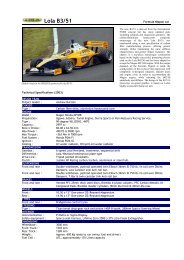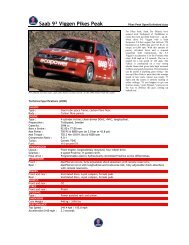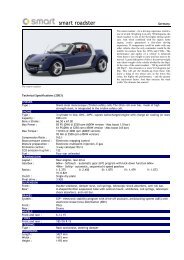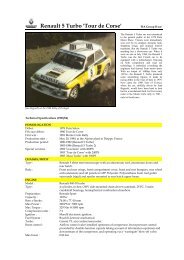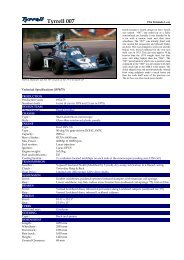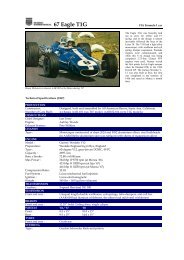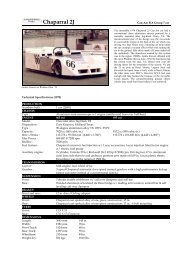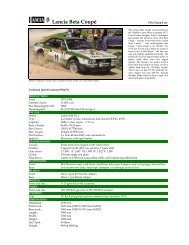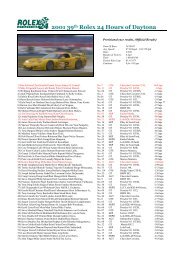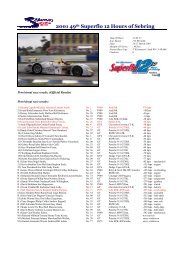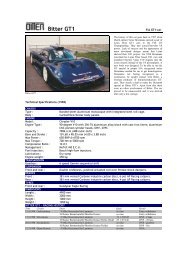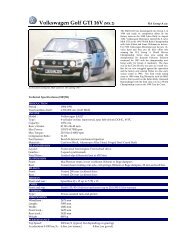83 Lancia Rally 037 - Motorsports Almanac
83 Lancia Rally 037 - Motorsports Almanac
83 Lancia Rally 037 - Motorsports Almanac
You also want an ePaper? Increase the reach of your titles
YUMPU automatically turns print PDFs into web optimized ePapers that Google loves.
<strong>Lancia</strong> had built the 200 necessary Stradale's by late March '82 and had their homologation confirmed in time to<br />
compete in the Costa Smerelda <strong>Rally</strong> beginning on April 1st. However, although customer versions of these<br />
competition cars were supposedly available for 53m Lira (£24,000), privateer cars would not be seen in any real number<br />
until half way through 19<strong>83</strong>. In the meantime, these first series <strong>037</strong>'s were used for little more than four months before<br />
the first Evolution version was homologated on Aug 1st. Contesting just six events between April and August, they<br />
either led or set fastest stage times on every occasion but worryingly managed to finish just twice from nine starts. A<br />
few high-profile teething problems weren't enough for Fiat to call time on the project though, no doubt having invested<br />
a cool £8m in the programme, they wanted to see it through. With 1982 a transitional year that saw Group 4 and B cars<br />
running alongside each other, you could have been excused for expecting <strong>Lancia</strong>'s little berlinetta to wipe the floor<br />
against a field of production-based Audi's, Opel's and Toyota's. But these well-developed cars had dominated World<br />
rallying over the previous few seasons while in Europe, more flexible rules allowed exotic machinery from the likes of<br />
Porsche and Ferrari to compete. Nevertheless, there was massive expectation surrounding <strong>Lancia</strong>'s return to the sport<br />
although realistically, the Turinese firm would do well to garner enough experience for genuine title assaults in year<br />
two. Season one got underway then on April 1st when a pair of <strong>037</strong>'s were wheeled out for their maiden Euro<br />
Championship outing, Sardinia's Costa Smerelda <strong>Rally</strong>. A fairly inauspicous debut saw both cars retire early on with<br />
gear selection problems although not before Markku Alen was able to set the fastest time on stage three. Three weeks<br />
later, the Mediterranean island of Elba hosted another important round of the ERC and <strong>Lancia</strong> entered a solitary<br />
Martini-liveried <strong>037</strong> for Adartico Vudafieri. Like Alén had done in Sardinia, 'Vuda' took fastest stage times with the car<br />
but after a brake retaining pin jammed, the Italian incurred an eight-minute penalty. He later experienced more gear<br />
selection problems and eventually wound up seventh whilst Fabrizio Tabaton won in an ageing Group 4 Stratos. May's<br />
fabled Tour de Corse followed and marked the <strong>037</strong>'s World <strong>Rally</strong> Championship debut, <strong>Lancia</strong> using two brand new<br />
cars for Bettega and Alén. But faring little better on the world stage, Alen clipped a rock early on and slightly twisted his<br />
spaceframe. Bettega meanwhile had been on the pace throughout although having lay third overnight, lost control of his<br />
car on day two and crashed heavily into a wall, breaking both legs in several places. Alen went on to finish ninth despite<br />
incurring another eight-minute penalty, this after he was unable to change a punctured wheel in the allocated time. For<br />
the Acropolis <strong>Rally</strong>, both cars arrived in Greece with shock absorbers for the steering, new front motor springs,<br />
suspension set 2.5cms higher, carbon sumpguards and alloy water radiators and Alen led on the cars first serious test<br />
over rough surfaces. But this was before the inevitable gearbox problems curtailed his progress whilst Bettega's<br />
replacement, Adartico Vudafieri, was struggling. An early puncture followed by a front suspension failure and then an<br />
accident with a spectators car frustrated the Italian, <strong>Lancia</strong> finally packing for home after his supercharger gave up the<br />
ghost. Back to the ERC and June's Ypres 24 Hour <strong>Rally</strong> saw Andrea Zanussi's factory-prepared Jolly Club car run, his<br />
Totip-backed machine arriving in Belgium only for FISA to have apparently withdrawn the <strong>037</strong>'s homologation due to<br />
some concern over its cooling system. Forced to compete under threat of exclusion at the finish, a potentially awkward<br />
situation was averted when the promising youngsters head gasket blew whilst running fourth. This should have been<br />
the final outing for <strong>Lancia</strong>'s first series <strong>037</strong> <strong>Rally</strong> as the firms Evolution version debuted in Madeira during the first week<br />
of August, but having planned to run an Evolution with carburettors instead of the troublesome injector system on the<br />
Halkidikis <strong>Rally</strong> in Greece, Zanussi actually used an older car. With it he led the early stages but broken shock absorbers<br />
and a flat tyre cost him around ten minutes, broken drive belts subsequently forcing him to retire after charging back<br />
from 52nd to fourth. Thus, the opening few months of 1982 had not been the whitewash some commentators were<br />
predicting at the start of the year and although the <strong>037</strong>'s had clearly demonstrated they had the pace to win rallies, their<br />
reliability over several days was still largely unproven. A major contributory factor to the incredible pace with which<br />
Group B machinery developed came from FISA allowing manufacturers to make improvements to their cars every few<br />
months. As a result, <strong>Lancia</strong>'s first programme of upgrades for the <strong>037</strong> were homologated on August 1st 1982, just four<br />
months after launch. Several key changes were introduced, the most obvious of which was a new look front-end that<br />
featured larger headlights and an adjustable chin spoiler. Attention was also paid to the tail where new circular light<br />
clusters and a prominent meshed grille replaced the Stradale-based facia of first series competition cars. Engine<br />
displacement remained unchanged at 1995cc, as did compression at 8.0:1, but a new intake manifold with Kugelfischer<br />
mechanical fuel injection and a Tipo R18 Abarth volumex supercharger meant output was up from 280 to 315bhp. Other<br />
changes saw the arrival of all-Kevlar doors, a new dash, some new suspension components, an improved steering gear<br />
and titanium rollcages, but weight was more or less unchanged at 975kg. The Evolution I made its debut on August 6th<br />
in the Madeira <strong>Rally</strong>, Andrea Zanussi holding the lead several times in his Totip-backed Jolly Club car before the motor<br />
began pouring oil at the end of the tenth stage. Finland's prestigious 1000 Lakes hosted the Evolution I on its WRC<br />
debut, Markku Alén's 310bhp car getting fifteen-inch wheels and harder springs but somewhat confusingly, a first series<br />
front end. With the oil and water overheating from the first stage, Alen did well to hold third until the engine terminally<br />
lost compression after five stages. Things began to improve for <strong>Lancia</strong> in the ERC's Tour de France showpiece where<br />
Jean Louis Clarr took over Zanussi's Jolly Club car after the Italian was called up for five days of National Service.<br />
Indeed, despite a failed distributor on the very first stage, Clarr recovered to take third behind the winning Ferrari and<br />
Therier's trouble-free Renault. Then, after an admittedly disappointing run on home soil in the San Remo <strong>Rally</strong>, Alén<br />
took the <strong>037</strong>'s first significant win, for although Teodoro had taken victory in an Italian hillclimb some two months<br />
previously, this was a bona fide championship rally. Indeed, part of the British National Championship, the Pace <strong>Rally</strong><br />
was Alen's warm-up for the WRC-sanctioned RAC event that took place every November. The Finn led from start to<br />
finish, setting fastest times on eight of the nine stages and winning despite a down on power engine with only 280bhp.<br />
But considering the <strong>037</strong>'s patchy reliability record, a trip to Africa for the Ivory Coast <strong>Rally</strong> seemed a little ambitious and<br />
unsurprisingly came to nothing. With supercharger pressure reduced to 0.6 bar for 270bhp, Adartico's Vudafieri's sole<br />
entry ran with protection bars and a roof-mounted spare until a misfiring engine and low oil pressure curtailed his



